Spain: Agriculture’s contribution to Spanish economy is less than 2% in seven regions
Spain’s economic structure continues to change rapidly. In seven of its regions, agriculture’s share of total value added is already less than 2%.
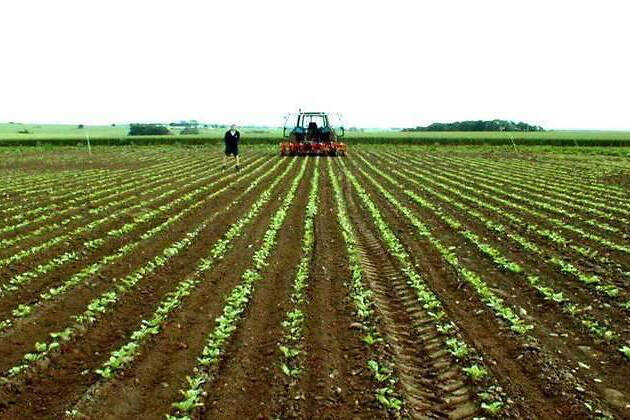
The unstoppable transformation of the Spanish economy towards the service sector –the so-called tertiarisation of the productive fabric- is crossing a new frontier. Agriculture, like industry, continues to lose weight in economic activity. And, in fact, it is no longer relevant for seven regions, in which agriculture represents less than 2% of regional gross added value (GAV).
These are Madrid (0.1%), Balearic Islands and Basque Country (0.8%), Cataluña (1%), Canary Islands (1.4%), Asturias (1.5%) and Cantabria (1.7%). These seven regions are by far the least exposed to agriculture, whereas in four regions the weight of the primary sector with respect to regional GAV exceeds at least 6%. These are Castilla-La Mancha (9.1%), Extremadura (8.6%), Andalucía (6.5%) and Aragón (6.3%). The country’s average stands at 2.9%.
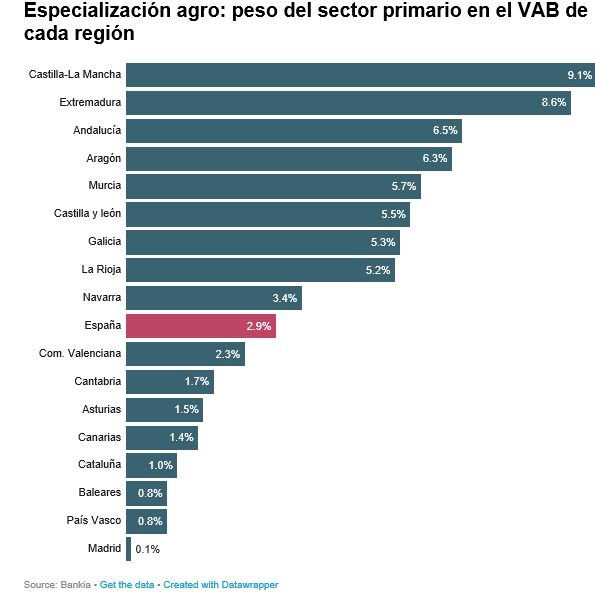
Agriculture in regional GAV
The power is in the south
The weakening of the primary sector has a decisive influence on the so-called “emptied” Spain, which is growing in parallel with the loss of importance of agriculture in favor of the service sector, which currently stands at 76% of national GDP.
All these figures appear in a recent report prepared by Bankia Research, reflecting an indisputable reality; the south continues to be the granary of Spain, to the point that, two regions, Andalucía and Castilla-La Mancha concentrate 40% of the total value added of agriculture.
This productive specialization of the southernmost regions in agriculture has to do, fundamentally, with the enormous weight of fruit and vegetable production, which accounts for two out of three euros; given that, Spain has a considerable competitive advantage for climatic reasons.
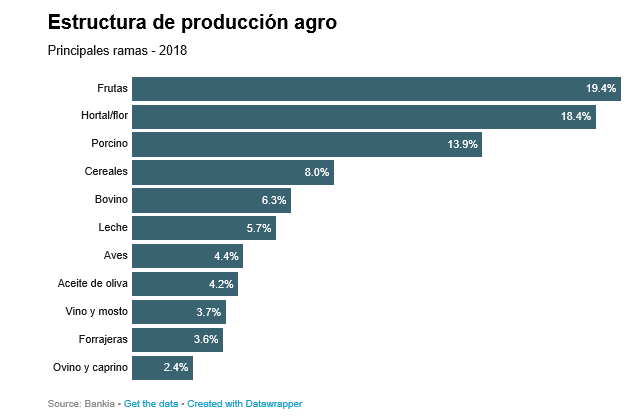
Structure of primary production in Spain
Cereals are a long way off fruit and vegetables, accounting for just 13% of plant production. As far as livestock production is concerned, the pig sector is the most significant one.
In any case, as the Bankia study reports, the lower weight of agriculture in relation to the economy as a whole has to do with the fact that the nominal GVA of the Spanish primary sector grew only 0.9% in 2018, being the smallest advance in four years, to €31.6 billion, 2.9% of the total.
Even so, the gross fixed capital formation (investments) has shown an upward trend in recent years. In 2016, it amounted to €4.9 billion, the highest figure since 2009, representing 2.2% of total investment in the Spanish economy. However, this investment is equivalent to a low percentage of the sector’s GVA: 16.2%, minimum since 2013.
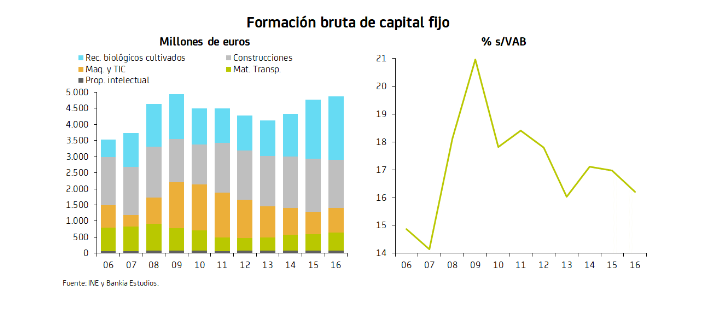
Gross fixed capital formation
Spanish agricultural output
In 2018, the agricultural production value increased by 5.5%, despite a slight fall in prices (-1%). Animal production balance was somewhat less positive than that of plant production, because the smaller increase in its production and the larger decrease in its prices, which in the case of pigs were so sharp (-6.5%) that they cancelled out the increase in production (+6%).
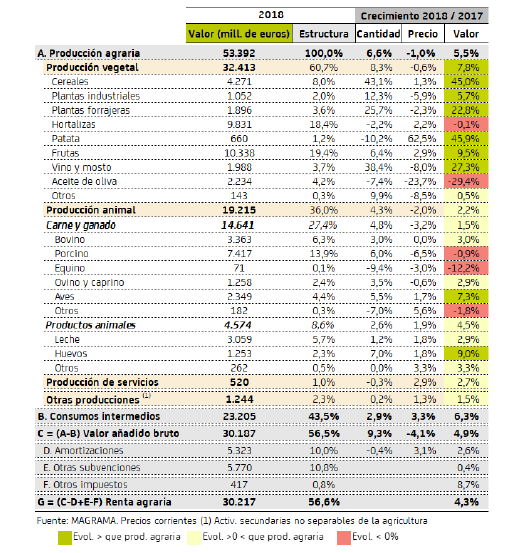
Spanish agricultural output in 2018
By crop, strong increase in the value of cereals, potatoes and fodder, after the 2017 decline, and wine and must, a segment that has accumulated a four-year growth. On the negative side, olive oil which fell sharply (-29.4%).
Food foreign trade
Exports from the agro food sector exceed €46 billion in annual terms, more than 16% of total Spanish exports.
Since 1996, the trade balance in this sector has been in surplus, stabilizing it around €11 billion over the last four years. This is the largest positive balance by sector in Spanish foreign trade. Both exports and imports have significantly lost momentum in the last two years: 2.4% and 1.6%, respectively, so far in 2019, in contrast to the dynamic rates of around 7% in 2015-17.
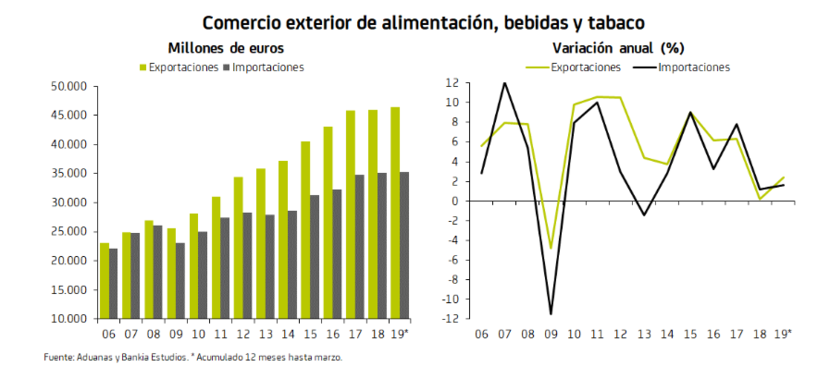
Foreign trade evolution of food, beverages and tobacco
However there are important differences by group: the surpluses for meat and, mainly, for fruit, vegetables and pulses contrast with the deficit data regarding cereals and fishery products.
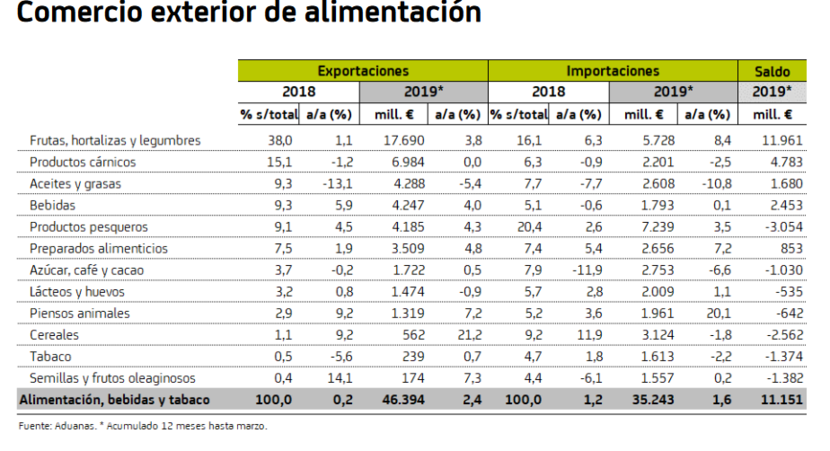
Foreign trade by food products
By region, Andalucía (23.4%), Catalonia (20.4%), Valencian Region (12.3%) and Murcia (10.7%) account for two thirds of agro food exports in Spain. Murcia, together with Extremadura, are the regions with the greatest weight of these products in their total foreign sales, close to 50%.
The full report in Spanish is available here: https://www.bankiaestudios.com/recursos/doc/estudios/20190603/junio/en-clave-agro-junio-2019.pdf#page=2&zoom=100,-200,657
Source: elconfidencial.com